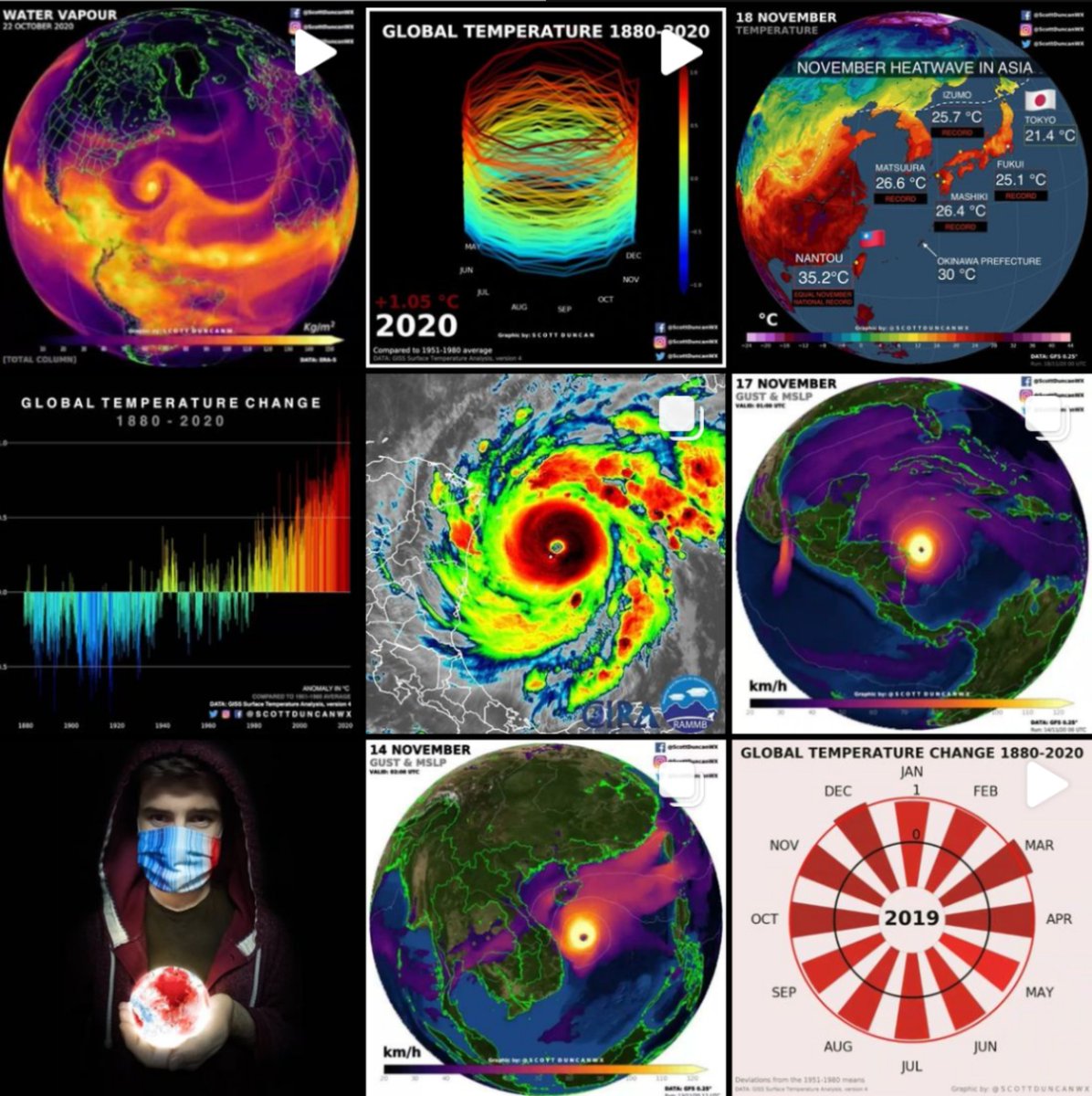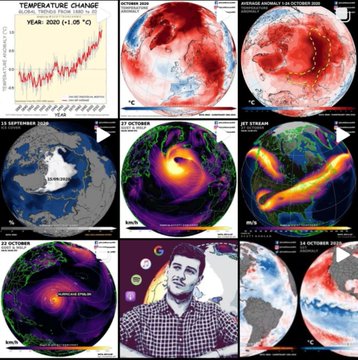
Earth has a fever in more ways than one. Some places averaged + 5-7 °C warmer than normal for the ENTIRE YEAR of 2020.
An enormous area of anomalous warmth plagued Arctic Siberia effectively all year but it was not just the Arctic where we saw record shattering warmth.
THREAD
An enormous area of anomalous warmth plagued Arctic Siberia effectively all year but it was not just the Arctic where we saw record shattering warmth.
THREAD
Another way of looking at it... Very few cold blobs left. La Niña developed and shows up in the Pacific.
The climate is not changing uniformly, the Arctic is warming much faster than the rest of the world.
Data: @CopernicusEU and compares to 1981-2010 average.
The climate is not changing uniformly, the Arctic is warming much faster than the rest of the world.
Data: @CopernicusEU and compares to 1981-2010 average.
JANUARY was joint hottest January globally on record according to NASA GISTEMP v4 (joint record with 2016).
Profound winter warmth for North America plus Europe and Asia.
Profound winter warmth for North America plus Europe and Asia.
FEBRUARY was second hottest on record (1st place is still held in 2016).
The winter 'warmth' in Europe and Asia was just insane.
The winter 'warmth' in Europe and Asia was just insane.
MARCH: A cold Canada, Greenland and Svalbard... but obvious warmth still striking across the continents, particularly northern/central Asia.
This was the second hottest March on record (2016 still holds the record).
This was the second hottest March on record (2016 still holds the record).
APRIL was hottest on record. North America pretty cool, quite impressive actually. But elsewhere...
Heat in the Arctic becoming quite a theme. Stick with me...
Heat in the Arctic becoming quite a theme. Stick with me...
MAY... hottest on record for month of May.
Do I need to point out northern parts of Asia any more?
Permafrost thawed and Russia suffered extreme diesel disaster. It began at the end of May. Criminal investigation ongoing: en.wikipedia.org/wiki/Norilsk_o…
Do I need to point out northern parts of Asia any more?
Permafrost thawed and Russia suffered extreme diesel disaster. It began at the end of May. Criminal investigation ongoing: en.wikipedia.org/wiki/Norilsk_o…
The Arctic circle broke its all time heat record in JUNE and the globe recorded its hottest month of June on record.
Arctic heat record: Siberian town called Verkhoyansk logged a temperature of 38° Celsius (100.4° Fahrenheit) on 6 June.
Arctic heat record: Siberian town called Verkhoyansk logged a temperature of 38° Celsius (100.4° Fahrenheit) on 6 June.
JULY was second hottest on record (July 2019 was hotter globally).
AUGUST... 3rd hottest on record.
Siberia and parts of North America really in the furnace, quite literally as wildfire season blazed into unchartered territory.
1,032,648 acres were lost in the August fire complex (Northern California) alone in. Record books were re-written.
Siberia and parts of North America really in the furnace, quite literally as wildfire season blazed into unchartered territory.
1,032,648 acres were lost in the August fire complex (Northern California) alone in. Record books were re-written.
SEPTEMBER... hottest on record.
South America stepped into the furnace with the start of one of the most profound/long-lived and widespread heatwaves in Southern Hemisphere history.
Siberia still doing its thing. Greenland turned blue though.
South America stepped into the furnace with the start of one of the most profound/long-lived and widespread heatwaves in Southern Hemisphere history.
Siberia still doing its thing. Greenland turned blue though.
OCTOBER... 5th hottest on record globally.
Arctic sea ice melted to record low extent for month of October and South America and started the month with extreme heat. Eastern Europe/Asia boundary set heat records widespread.
Cool north America and developing La Nina...
Arctic sea ice melted to record low extent for month of October and South America and started the month with extreme heat. Eastern Europe/Asia boundary set heat records widespread.
Cool north America and developing La Nina...
NOVEMBER marks the 6th all time monthly heat record in 2020. 2020 now contains at least half the monthly heat records globally.
Arctic looks like it is on fire here. This is not surprising given the lack of sea ice. Textbook Arctic amplification.
Cold in central Asia.
Arctic looks like it is on fire here. This is not surprising given the lack of sea ice. Textbook Arctic amplification.
Cold in central Asia.
DECEMBER... well... I await official stats for ranking.
Deep cold again in Central Asia but warm pretty much everywhere else. North America, Northern Europe and Africa breaking records.
Stay tuned.
Deep cold again in Central Asia but warm pretty much everywhere else. North America, Northern Europe and Africa breaking records.
Stay tuned.
This is not an exhaustive list of records and profound weather/climate events from 2020.
A more organised collection of graphics exists on my instagram: instagram.com/scottduncanwx/

A more organised collection of graphics exists on my instagram: instagram.com/scottduncanwx/


COVID and politics took centre stage in 2020 for very obvious reasons.
This thread serves as a reminder that the climate has changed and is continuing to change. Changes are not uniform, I hope everyone can see this.
This thread serves as a reminder that the climate has changed and is continuing to change. Changes are not uniform, I hope everyone can see this.
To those who kindly keep pointing out that my previous animations have the world spinning the wrong way.
I have corrected this. Happy new year 👍
I have corrected this. Happy new year 👍
We are awaiting official verification as to whether 2020 was the warmest year on record.
Inevitably top 3. Probably at least 2nd. Could be hottest.
JMA preliminary data has 2020 at the top spot.
Inevitably top 3. Probably at least 2nd. Could be hottest.
JMA preliminary data has 2020 at the top spot.
It is worth noting that some months are warming faster than others too.
Often January, February and March have the largest anomalies, some of which already break the +1.5 °C anomaly (comparing to levels similar to pre-industrial times).
Often January, February and March have the largest anomalies, some of which already break the +1.5 °C anomaly (comparing to levels similar to pre-industrial times).
Oh... I nearly forgot.
This might come in useful. Solar and carbon graphs combined with temperature.
scottduncanwx.com/carbon-vs-sola…
This might come in useful. Solar and carbon graphs combined with temperature.
scottduncanwx.com/carbon-vs-sola…
• • •
Missing some Tweet in this thread? You can try to
force a refresh








